6 new books to keep you eye out for..
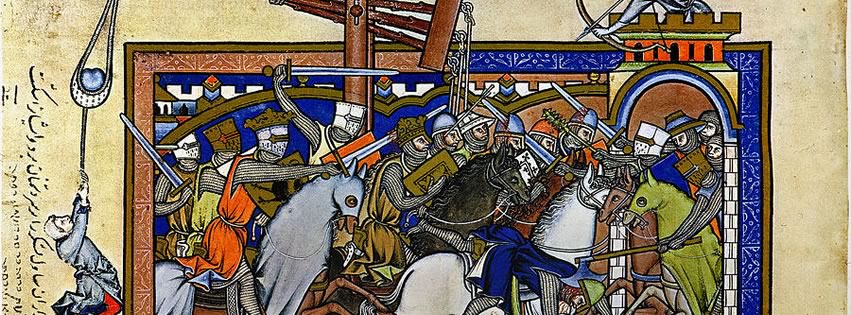
 There is a huge upsurge in interest in ancient and medieval warfare and I wanted to share six new or coming soon titles you should keep an eye out for from pen and Sword books.
There is a huge upsurge in interest in ancient and medieval warfare and I wanted to share six new or coming soon titles you should keep an eye out for from pen and Sword books.
 The Two-Handed Sword
The Two-Handed Sword
https://www.pen-and-sword.co.uk/The-Two-Handed-Sword-Hardback/p/15316
The two-handed swords found in modern museums are often so large and elaborately decorated that the onlooker might question whether such an apparently impractical weapon could ever have been a serious weapon of war. Yet during the Late Middle Ages, although never numerous, such weapons could instil dread in those that faced them on the battlefield and in skilled hands posed a very real danger, being capable of inflicting fearsome wounds. Neil Melville explains how, from the late-13th century, technological advances made the development of larger swords requiring both hands both possible and desirable. From their origins in Germany he traces their development and divergence into regional variations. He examines the evidence for their use on the battlefield over 300 years, most notably in the hands of the Swiss, the German landsknechts and the Scottish clans, before considering their later use in fencing and as ceremonial weapons. Practical advice on fighting with the two-handed sword is also given, drawing on contemporary fencing manuals. The detailed and informative text is beautifully enhanced by dozens of illustrations.
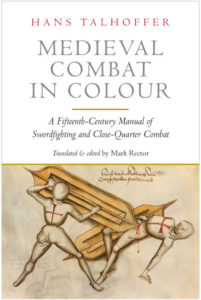 Medieval Combat in Colour
Medieval Combat in Colour
https://www.pen-and-sword.co.uk/Medieval-Combat-in-Colour-Paperback/p/14803
Hans Talhoffer’s professional fencing manual of 1467 illustrates the intricacies of the medieval art of fighting, covering both the ‘judicial duel’ (an officially sanctioned fight to resolve a legal dispute) and personal combat. Combatants in the Middle Ages used footwork, avoidance, and the ability to judge and manipulate timing and distance to exploit and enhance the sword’s inherent cutting and thrusting capabilities. These skills were supplemented with techniques for grappling, wrestling, kicking and throwing the opponent, as well as disarming him by seizing his weapon. Every attack contained a defence and every defence a counter-attack. Talhoffer reveals the techniques for wrestling, unarmoured fighting with the long sword, pole-axe, dagger, sword and buckler, and mounted combat. This unparalleled guide to medieval combat, illustrated with 268 contemporary images, provides a glimpse of real people fighting with skill, sophistication and ruthlessness. This is one of the most popular and influential manuals of its kind.
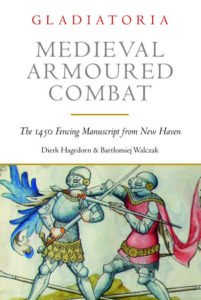 Medieval Armoured Combat
Medieval Armoured Combat
https://www.pen-and-sword.co.uk/Medieval-Armoured-Combat-Paperback/p/15254
The “Gladiatoria” group of German fencing manuscripts are several editions of a treatise on armoured foot combat, specifically aimed at duel fighting.
Gloriously-illustrated, and replete with substantial commentary, these works are some of the greatest achievements in the corpus of late medieval fight books. These works have both tremendous artistic merit and incalculable historical value.
In this remarkable full colour volume, authors Dierk Hagedorn and Bartłomiej Walczak elegantly present their work on the copy of this treatise now in the Yale Center for British Art, including a reproduction of the manuscript, a full transcription, and translations into English.
The work includes a foreword by Sydney Anglo which explains how the work shows a highly sophisticated pedagogical system of movement and applauds the editors for presenting the material in a clear and practical way.
Additional essays discuss other aspects of the manuscript – including a tale of Dierk Hagedorn’s adventures tracking down the manuscript.
 On Ancient Warfare
On Ancient Warfare
https://www.pen-and-sword.co.uk/On-Ancient-Warfare-Hardback/p/15277
Richard Gabriel has been studying and writing about ancient warfare for nearly half a century. He has written fifty-five books on the subject (before this one) and over three hundred published articles. These decades of scholarship are complemented by direct military experience as a US army officer (now retired). This book presents his thoughts and perspectives on a selection of aspects of ancient warfare that he has found of particular interest over the years. It does not aim to be a comprehensive overview nor a coherent narrative of ancient military history but adds up to an illuminating, fascinating and wide-ranging discussion of various topics. With topics ranging from broad topics such as the origins of war, through logistics, military medicine and psychiatry or the origins of jihad, to specifics such as the generalship of Alexander the Great (Gabriel’s not a fan), Scipio and Hannibal, there is plenty here for the either the general reader or academic scholar.
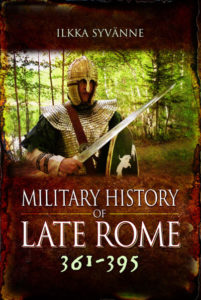 The Military History of Late Rome 361-395
The Military History of Late Rome 361-395
https://www.pen-and-sword.co.uk/The-Military-History-of-Late-Rome-361-395-Hardback/p/6180
This is the second volume in an ambitious series giving the reader a comprehensive narrative of late Roman military history from AD 284-641. Each volume (5 are planned) gives a detailed account of the changes in organization, equipment, strategy and tactics among both the Roman forces and her enemies in the relevant period, while also giving a detailed but accessible account of the campaigns and battles. This volume covers the tumultuous period from the death of Constantius II in AD 361 to the death of Theodosius. Among the many campaigns covered, it therefore includes the Emperor Julian’s fatal campaign against the Sassanian Persians and the disastrous defeat and death of Valens at Adrianople in 378. Such calamities illustrate the level of external threat Rome’s armies faced on many fronts in this difficult period.
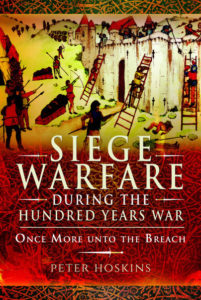 Siege Warfare during the Hundred Years War
Siege Warfare during the Hundred Years War
https://www.pen-and-sword.co.uk/Siege-Warfare-during-the-Hundred-Years-War-Hardback/p/15545
Histories of the Hundred Years War have been written, and accounts of the famous battles, but until now no book has concentrated on the sieges that played a decisive role in the protracted struggle between England and France. Edward III’s capture of Calais in 1347 was of crucial importance for the English, and the failure of the English siege of Orléans in 1429 was a turning point for the French after the disaster of Agincourt. Throughout the war, sieges were a major weapon in the strategic armouries of both sides, and Peter Hoskins’s perceptive and graphic study is a fascinating analysis of them.
He describes the difficulties faced by besieger and besieged, examines the logistics and resource implications of sieges, and provides a comparative assessment of siege warfare alongside set-piece battles and the English strategy of chevauchées. Key sieges are reconstructed in vivid detail, other sieges are summarized, and the book is fully illustrated with photographs and plans.
< BACK